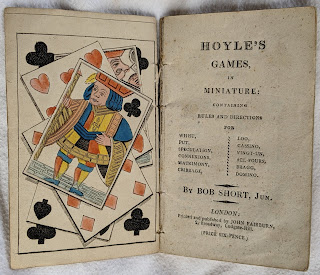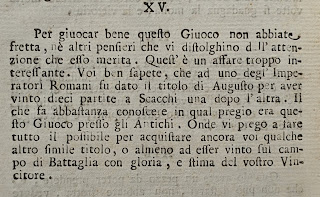The Hoyle I purchase at a German auction in late November has finally arrived. Before taking a close look at it, let's return to the December auction where I bought four lots, fourteen books, including the whist manuscript discussed in the last essay. There were some early books on the game of ombre, but I'll focus on the Hoyles. My collection is deep and the opportunities for me are mostly with cheap literature and with translations.
For cheap literature, it is hard to top this Hoyle's Games in Miniature, purportedly by Bob Short, Jun.
 |
| Hoyle in Miniature 1825c. Levy [2160] |
I've written about the chapbooks by "Bob Short," which I have shown is the pseudonym of Robert Withy (see "Who is 'Bob Short'?" parts one, two, and three). Like Hoyle himself, Bob Short became a brand. Withy himself wrote only about whist and quadrille in the 1780s and 1790s, but in the first half of the 19th century, you could find all sorts of chapbooks and cheap books offered under his pseudonym, sometimes, as here, with a disingenuous "Jun." appended. There is a charming and naive hand-colored frontispiece:
 |
| frontispiece and title page |
This is a reissue of a book first published in 1820 or so. The original book was imposed in eights; the reissue in sixes, still the same setting of type. The reissue also adds eight pages on the games of brag and domino, which are listed on the title page, but not on the wrapper. These cheap books are quite rare. The only copy of the first issue is at the Bodleian Library and mine is one of two surviving second issues.
I'll show without comment two French translations of Hoyle treatise on whist, one published in the Hague by Staatman in 1765, the other in Amsterdam by Prault in 1767.
 |
| Staatman 1765 Levy [2159] |
 |
| Prault 1767 Levy [2158] |
Now onto the gem. In general, editions of Hoyle are objects of commerce, not luxury. With the exception of the first edition of Hoyle's first book, pictured here, the bindings are cheap, utilitarian, and not particularly attractive. Here is a second exception, albeit a bit stained:
 | ||
| deluxe Italian? binding |
The book is an Italian translation of Hoyle on chess printed in Florence in 1768.
 |
| Scacchi, Florence, 1768 Levy [2170] |
The long title translates as The game of chess with some rules and observations to play it well, by the Englishman Mr. Hoyle translated into our language and dedicated to incomparable merit of Mr. Dudley Digges, English officer of the navy in the service of his British Majesty. We'll return to Mr. Digges in a moment. The book is quite rare with only three institutional copies in major chess collections: the White collection at Cleveland Public (pictured here), the van der Linde collection at the Koninklijke Bibliotheek (available on Google), and the Fiske collection at the National and University Library in Iceland. A label in my copy says it is a duplicate from the collection of Lothar Schmid (1928-2013), so perhaps a fifth copy remains in that collection, which I understand is still intact.
The text is not from Hoyle's 1761 work on chess, as one might expect, but rather from the second half of Hoyle's treatise on piquet, first published in 1744, and included in all editions of Hoyle's Games thereafter. To give a sense of the typography, here is the beginning of the text:
 |
| Chess, part one |
There are a few additions by the translator. The first is a two-page letter to the reader:
 |
| Translator's preface |
The translator is Ranieri Collini and the preface expresses fawning admiration of Digges. Some rough translations:
"To whom better than you to be able to dedicate this book..."
"...having reendered yourself ably in the service of your august monarch..."
"...long undertakings, and painful voyages by land and sea..."
"I know that your soul is very alien to conceit..."
In the third and final section of the book, Hoyle had 14 numbered paragraphs and Collini adds a fifteenth:
 |
| Part 3, paragraph XV |
It connects the game of chess to antiquity, noting that the title of Augustus was given to one of the imperial Romans for having won ten games of chess in a row. I haven't seen that anecdote before!
So how did Collini and Digges cross paths? A Dictionary of British and Irish Travellers in Italy, 1701-1800, Yale University Press, 1997 is based on an archive assembled by Sir Birnsley Ford and edited by John Ingamells. It is an alphabetical listing of visitors to Italy, many undertaking the grand tour. The dictionary shows Captain Dudley Digges and his brother West Digges visiting Florence in 1767, a year before the Hoyle was published:
 |
| Dictionary p301 |
Astonishingly, the source document, Gazzetta Toscana, is available on Google books. An entry marked "Florence, December 26, 1767" reads:
 |
| Gazzetta Toscana, p215 |
Correcting the misspelling of the names, this translates in part:
"Among the foreign gentlemen who came to this capital in the space of eight days are...Messrs. Belven, West Digges, English gentlemen, Mr. Dudley Digges, captain in service of his British Majesty."
I have not been able to track down Belven. West Digges is a quite well-known comic actor, but if Collini had met them both, he must have been more impressed with brother Dudley. The text in the gazette almost matches the dedication on the title page. So it is possible to connect Collini and Digges in time and space. It would be fascinating to learn how they came to meet.
It took more than six weeks for this gem to travel here, but it was well worth the wait, don't you think?




No comments:
Post a Comment